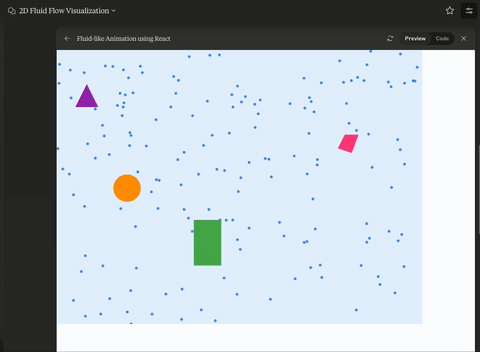I spent some time working with Claude Artifacts for the first time. I started with this prompt
I want to see what you can do. Can you please create a 2d rendering of fluid moving around obstacles of different shapes?
In effort to not spend this whole post quoting prompts I need to figure out a better way to share conversations from all the different models I interact with, including multi-modal models. Ideally, I could export these in a consistent JSON structure to make rendering them in a standard conversation format easier. Static media (images, video, etc.) would be straightforward but things like Artifacts, which are rendered by the Claude UI fit this structure less cohesively. , I’ve exported the whole conversation returned from the Anthropic API, using the response from the following endpoint This API may change in the future. It isn’t an externally-documented API. .
https://claude.ai/api/organizations/<org_id>/chat_conversations/<conversation_id>?tree=True&rendering_mode=raw
Initial Prompt and Response#
Claude outputted a static SVG as its first attempt at solving this problem. I followed up that I wanted to animate it. First it tried to do that with a library called Matter.js, but it seemed Artifacts didn’t have access to that. I told Claude and it created a different version with its own simple physics.
This result was a nice, working example. It wasn’t exactly what I had in mind, which was something like this WebGL Fluid Simulation, but I’ll concede that that isn’t exactly what I asked for. I didn’t know the right terminology I tried starting a new conversation, prompting Claude to “Create a fluid simulation with WebGL” but got “Output blocked by content filtering policy” which was disappointing. when I started.
Iterating on the Artifact#
I prompted several more times to have Claude improve collision detection, add more shapes and add interactions between the particles. I also tried to make it so I could click and drag around the shapes with my mouse. I (Claude) never fully got any of these working. Some generations were incrementally closer, but didn’t quite accomplish was I was aiming for.

When I prompted Claude to make an improvement or fix a mistake, it occasionally simplified the problem to try and get a working version of the isolated feature I was asking for, like when I prompted to add the ability to move the shapes around with the mouse. This helped it get back on track, but wasn’t really what I wanted, which was to have the feature added to the working version of the code we were iterating on.
Limitations of Artifacts for Software Development#
This experience brings me to my main complaint about Artifacts from the perspective of a software engineer. I want to collaborate with the model and specifically target areas where it makes changes and improvements in certain cases. I also do not want to regenerate the entire artifact after every prompt. I want to build incrementally on top of what is working. Waiting for a full regeneration is more time consuming and the model sometimes changes parts of the code that I would have preferred to keep the same. I could see myself using Artifacts as a starting point or for ideation, but Sonnet 3.5 + Cursor has been a much nicer experience as an engineer hoping to iterate, make more targeted changes and make my own edits to the code. Also, I mostly prefer the development environment in Cursor to the Claude UI.
Context Window Challenges#
After many iterations in the Claude UI, I got this error message
Your message will exceed the length limit for this chat. Try shortening your message or starting a new conversation. Or consider upgrading to Claude Pro.
I’m happy to upgrade to a paid product (I mostly pay for model APIs these days), but this raises another issue with this approach for iterating on software – the context window. Even with a larger context window that would have let me send many more messages, I’ve experienced a few problems with an append-only conversation history.
- We don’t want or need many of the failed attempts in the context and retaining them sometimes seems to continue to steer the model in the wrong direction, even for subsequent generations
- The inference is slower and more expensive with more tokens
- The quality of the inference seems to degrade with larger context – this is a vibes-based take, I don’t have hard data to back it up and it seems to be improving
Claude 3.5 Sonnet is my favorite model right now.
I’d would say I prefer claude-3.5-sonnet over gpt-4o more than I preferred claude-3-opus over gpt-4-turbo.
I enjoyed seeing Anthropic dive into the model+tool arena and I’m looking forward to seeing how they continue to iterate from here.